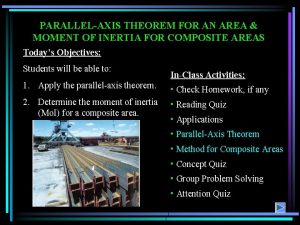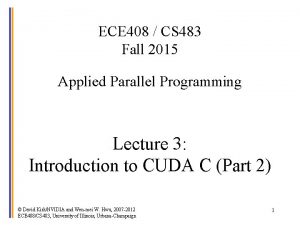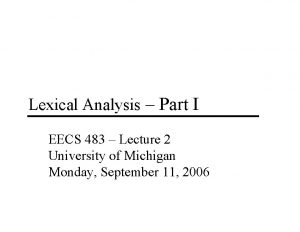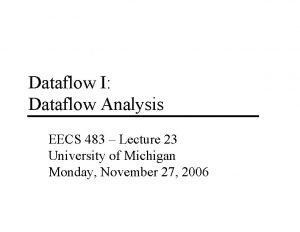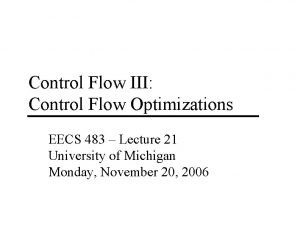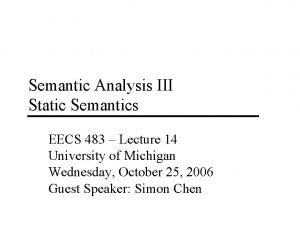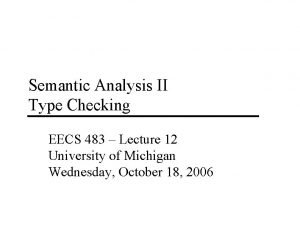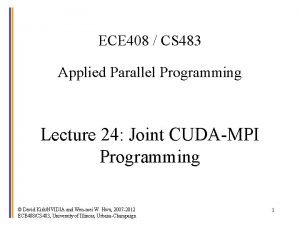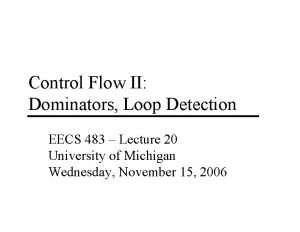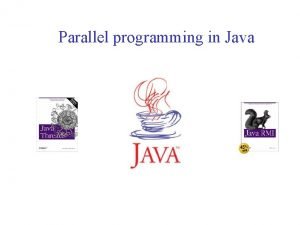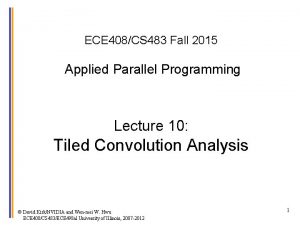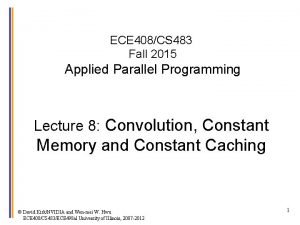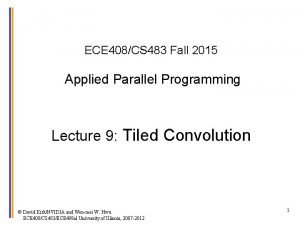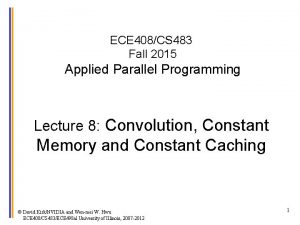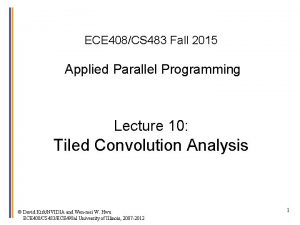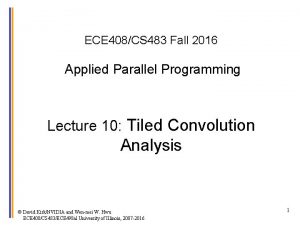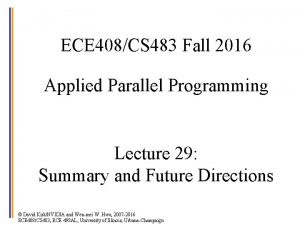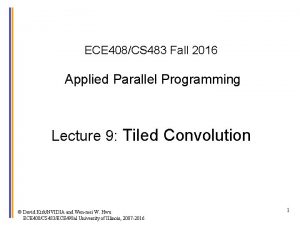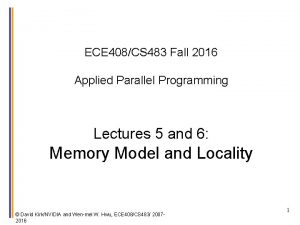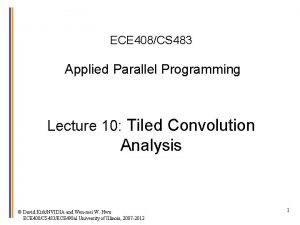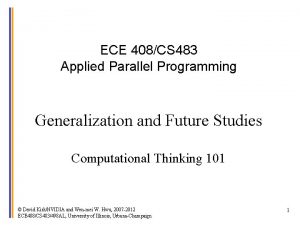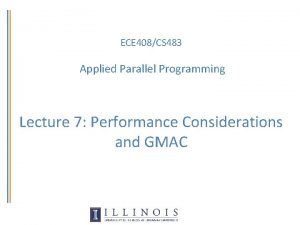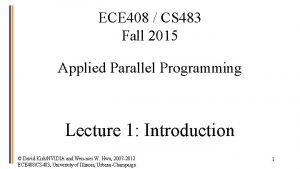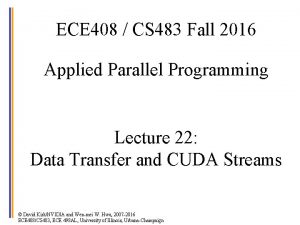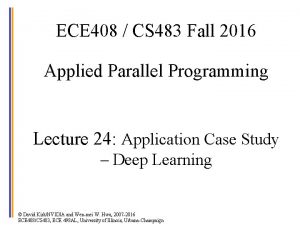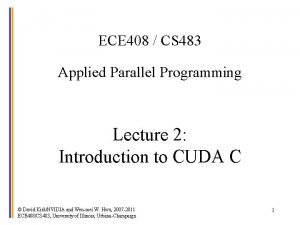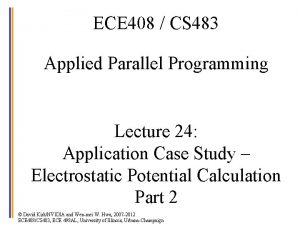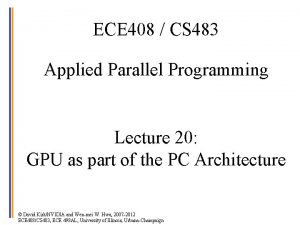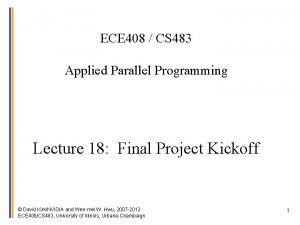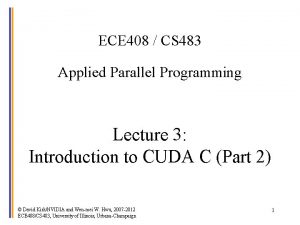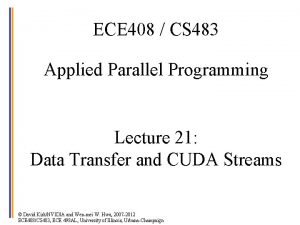ECE 408CS 483 Fall 2015 Applied Parallel Programming




















![Loading an Input Tile m bx 1 tx TILE_WIDTH N m N[m*TILE_WIDTH+ty][Col] N[(m*TILE_WIDTH+ty) * Loading an Input Tile m bx 1 tx TILE_WIDTH N m N[m*TILE_WIDTH+ty][Col] N[(m*TILE_WIDTH+ty) *](https://slidetodoc.com/presentation_image/3233b1e0e3e78645b83e7d14faf9ca81/image-21.jpg)







- Slides: 28

ECE 408/CS 483 Fall 2015 Applied Parallel Programming Lectures 5 and 6: Memory Model and Locality © David Kirk/NVIDIA and Wen-mei W. Hwu, ECE 408/CS 483/ 20072012 1

Programmer View of CUDA Memories • Each thread can: – Read/write per-thread registers (~1 cycle) – Read/write per-block shared memory (~5 cycles) – Read/write per-grid global memory (~500 cycles) – Read/only per-grid constant memory (~5 cycles with caching) Grid Block (0, 0) Block (1, 0) Shared Memory Registers Thread (0, 0) Thread (1, 0) Host Shared Memory Registers Thread (0, 0) Thread (1, 0) Global Memory Constant Memory 2 © David Kirk/NVIDIA and Wen-mei W. Hwu, ECE 408/CS 483/ECE 498 al, 2007 -2012

CUDA Variable Type Qualifiers Variable declaration Memory Scope Lifetime int Local. Var; register thread __device__ __shared__ int Shared. Var; shared block __device__ int Global. Var; global grid application constant grid application __device__ __constant__ int Constant. Var; • __device__ is optional when used with __shared__, or __constant__ • Automatic variables without any qualifier reside in a register – Except per-thread arrays that reside in global memory 3 © David Kirk/NVIDIA and Wen-mei W. Hwu, ECE 408/CS 483/ECE 498 al, 2007 -2012

__global__ void Matrix. Mul. Kernel(float* M, float* N, float* P, int Width) { __shared__ float sub. Tile. M[TILE_WIDTH]; __shared__ float sub. Tile. N[TILE_WIDTH]; 4 © David Kirk/NVIDIA and Wen-mei W. Hwu ECE 408/CS 483/ECE 498 al University of Illinois, 2007 -2011

A Common Programming Strategy • Global memory resides in device memory (DRAM) • A profitable way of performing computation on the device is to tile the input data to take advantage of fast shared memory: – Partition data into subsets that fit into shared memory – Handle each data subset with one thread block by: • Loading the subset from global memory to shared memory, using multiple threads to exploit memory-level parallelism • Performing the computation on the subset from shared memory; each thread can efficiently multi-pass over any data element • Copying results from shared memory to global memory 5 © David Kirk/NVIDIA and Wen-mei W. Hwu, ECE 408/CS 483/ECE 498 al, 2007 -2012

Matrix-Matrix Multiplication using Shared Memory 6 © David Kirk/NVIDIA and Wen-mei W. Hwu, ECE 408/CS 483/ECE 498 al,

A Simple Matrix Multiplication Kernel __global__ void Matrix. Mul. Kernel(float* M, float* N, float* P, int Width) { // Calculate the row index of the P element and M int Row = block. Idx. y * block. Dim. y + thread. Idx. y; // Calculate the column index of P and N int Col = block. Idx. x * block. Dim. x + thread. Idx. x; if ((Row < Width) && (Col < Width)) { float Pvalue = 0; // each thread computes one element of the block sub-matrix for (int k = 0; k < Width; ++k) Pvalue += M[Row*Width+k] * N[k*Width+Col]; P[Row*Width+Col] = Pvalue; } } © David Kirk/NVIDIA and Wen-mei Hwu, 2007 -2012 ECE 408/CS 483/ECE 498 al, University of Illinois, Urbana-Champaign

How about performance? • All threads access global memory for their input matrix elements – – Two memory accesses (8 bytes) per floating point multiply-add 4 B/s of memory bandwidth/FLOPS 4*1, 000 = 4, 000 GB/s required to achieve peak FLOP rating 150 GB/s limits the code at 37. 5 GFLOPS • The actual code runs at about 25 Host GFLOPS on Fermi • Need to drastically cut down memory accesses to get closer to the peak 1, 000 GFLOPS © David Kirk/NVIDIA and Wen-mei W. Hwu ECE 408/CS 483/ECE 498 al University of Illinois, 2007 -2011 Grid Block (0, 0) Block (1, 0) Shared Memory Registers Thread (0, 0) Thread (1, 0) Global Memory Constant Memory 8

Shared Memory Blocking Basic Idea in Global Memory Thread 1 Thread 2 … Global Memory in On-chip Memory Thread 1 © David Kirk/NVIDIA and Wen-mei W. Hwu, ECE 408/CS 483/ECE 498 al, 2007 -2012 Thread 2 … 9

Outline of Technique • Identify a block/tile of global data that are accessed by multiple threads • Load the block/tile from global memory into onchip memory • Have the multiple threads to access their data from the on-chip memory • Move on to the next block/tile 10 © David Kirk/NVIDIA and Wen-mei W. Hwu, ECE 408/CS 483/ECE 498 al, 2007 -2012

Idea: Use Shared Memory to reuse global memory data • Each input element is read by WIDTH threads. • Load each element into Shared Memory and have several threads use the local version to M reduce the memory bandwidth WIDTH N P WIDTH ty tx WIDTH © David Kirk/NVIDIA and Wen-mei W. Hwu, ECE 408/CS 483/ECE 498 al, 2007 -2012 WIDTH 11

bx Tiled Multiply M 1 2 tx TILE_WIDTH N WIDTH 0 1 2 TILE_WIDTH-1 TILE_WIDTH • Break up the execution of the kernel into phases so that the data accesses in each phase is focused on one subset (tile) of M and N 0 P 1 ty 0 1 2 TILE_WIDTH-1 TILE_WIDTH 2 © David Kirk/NVIDIA and Wen-mei W. Hwu, ECE 408/CS 483/ECE 498 al, 2007 -2012 WIDTH by TILE_WIDTHE 0 TILE_WIDTH 12

Loading a Tile • All threads in a block participate – Each thread loads one Md element and one Nd element in based tiled code • Assign the loaded element to each thread such that the accesses within each warp is coalesced (more later). 13 © David Kirk/NVIDIA and Wen-mei W. Hwu, ECE 408/CS 483/ECE 498 al, 2007 -2012

Work for Block (0, 0) SM N 0, 0 N 0, 1 N 0, 2 N 0, 3 N 0, 0 N 0, 1 N 1, 0 N 1, 1 N 1, 2 N 1, 3 N 1, 0 N 1, 1 N 2, 0 N 2, 1 N 2, 2 N 2, 3 N 3, 0 N 3, 1 N 3, 2 N 3, 3 SM M 0, 0 M 0, 1 M 0, 2 M 0, 3 M 0, 0 M 0, 1 P 0, 0 P 0, 1 P 0, 2 P 0, 3 M 1, 0 M 1, 1 M 1, 2 M 1, 3 M 1, 0 M 1, 1 P 1, 0 P 1, 1 P 1, 2 P 1, 3 M 2, 0 M 2, 1 M 2, 2 M 2, 3 P 2, 0 P 2, 1 P 2, 2 P 2, 3 M 3, 0 M 3, 1 M 3, 2 M 3, 3 P 3, 0 P 3, 1 P 3, 2 P 3, 3 © David Kirk/NVIDIA and Wen-mei W. Hwu, ECE 408/CS 483/ECE 498 al, 2007 -2012 14

Work for Block (0, 0) N 0, 0 N 0, 1 N 0, 2 N 0, 3 SM N 1, 0 N 1, 1 N 1, 2 N 1, 3 N 0, 0 N 0, 1 N 1, 0 N 1, 1 N 2, 0 N 2, 1 N 2, 2 N 2, 3 N 3, 0 N 3, 1 N 3, 2 N 3, 3 SM M 0, 0 M 0, 1 M 0, 2 M 0, 3 M 0, 0 M 0, 1 P 0, 0 P 0, 1 P 0, 2 P 0, 3 M 1, 0 M 1, 1 M 1, 2 M 1, 3 M 1, 0 M 1, 1 P 1, 0 P 1, 1 P 1, 2 P 1, 3 M 2, 0 M 2, 1 M 2, 2 M 2, 3 P 2, 0 P 2, 1 P 2, 2 P 2, 3 M 3, 0 M 3, 1 M 3, 2 M 3, 3 P 3, 0 P 3, 1 P 3, 2 P 3, 3 15 © David Kirk/NVIDIA and Wen-mei W. Hwu, ECE 408/CS 483/ECE 498 al, 2007 -2012

Work for Block (0, 0) N 0, 0 N 0, 1 N 0, 2 N 0, 3 SM N 1, 0 N 1, 1 N 1, 2 N 1, 3 N 0, 0 N 0, 1 N 1, 0 N 1, 1 N 2, 0 N 2, 1 N 2, 2 N 2, 3 N 3, 0 N 3, 1 N 3, 2 N 3, 3 SM M 0, 0 M 0, 1 M 0, 2 M 0, 3 M 0, 0 M 0, 1 P 0, 0 P 0, 1 P 0, 2 P 0, 3 M 1, 0 M 1, 1 M 1, 2 M 1, 3 M 1, 0 M 1, 1 P 1, 0 P 1, 1 P 1, 2 P 1, 3 M 2, 0 M 2, 1 M 2, 2 M 2, 3 P 2, 0 P 2, 1 P 2, 2 P 2, 3 M 3, 0 M 3, 1 M 3, 2 M 3, 3 P 3, 0 P 3, 1 P 3, 2 P 3, 3 16 © David Kirk/NVIDIA and Wen-mei W. Hwu, ECE 408/CS 483/ECE 498 al, 2007 -2012

Work for Block (0, 0) N 0, 0 N 0, 1 N 0, 2 N 0, 3 N 1, 0 N 1, 1 N 1, 2 N 1, 3 N 2, 0 N 2, 1 N 2, 2 N 2, 3 N 2, 0 N 2, 1 N 3, 0 N 3, 1 N 3, 2 N 3, 3 N 3, 0 N 1, 3 SM M 0, 0 M 0, 1 M 0, 2 M 0, 3 P 0, 0 P 0, 1 P 0, 2 P 0, 3 M 1, 0 M 1, 1 M 1, 2 M 1, 3 P 1, 0 P 1, 1 P 1, 2 P 1, 3 M 2, 0 M 2, 1 M 2, 2 M 2, 3 P 2, 0 P 2, 1 P 2, 2 P 2, 3 M 3, 0 M 3, 1 M 3, 2 M 3, 3 P 3, 0 P 3, 1 P 3, 2 P 3, 3 © David Kirk/NVIDIA and Wen-mei W. Hwu, ECE 408/CS 483/ECE 498 al, 2007 -2012 17

Work for Block (0, 0) N 0, 0 N 0, 1 N 0, 2 N 0, 3 N 1, 0 N 1, 1 N 1, 2 N 1, 3 N 2, 0 N 2, 1 N 2, 2 N 2, 3 SM N 3, 0 N 3, 1 N 3, 2 N 3, 3 N 2, 0 N 2, 1 N 3, 0 N 1, 3 SM M 0, 0 M 0, 1 M 0, 2 M 0, 3 P 0, 0 P 0, 1 P 0, 2 P 0, 3 M 1, 0 M 1, 1 M 1, 2 M 1, 3 P 1, 0 P 1, 1 P 1, 2 P 1, 3 M 2, 0 M 2, 1 M 2, 2 M 2, 3 P 2, 0 P 2, 1 P 2, 2 P 2, 3 M 3, 0 M 3, 1 M 3, 2 M 3, 3 P 3, 0 P 3, 1 P 3, 2 P 3, 3 © David Kirk/NVIDIA and Wen-mei W. Hwu, ECE 408/CS 483/ECE 498 al, 2007 -2012 18

Loading an Input Tile 0 0 bx 1 2 tx Accessing tile 0 2 D indexing: TILE_WIDTH N TILE_WIDTH M[Row][tx] N[ty][Col] M WIDTH 0 1 2 TILE_WIDTH-1 P 0 1 2 TILE_WIDTH-1 TILE_WIDTH 2 WIDTH by 1 ty TILE_WIDTHE 0 TILE_WIDTH 19

Loading an Input Tile 1 0 bx 1 2 tx Accessing tile 1 in 2 D indexing: TILE_WIDTH N M TILE_WIDTH M[Row][1*TILE_WIDTH+tx] N[1*TILE_WIDTH+ty][Col] WIDTH 0 1 2 TILE_WIDTH-1 P 0 1 2 TILE_WIDTH-1 TILE_WIDTH 2 WIDTH by 1 ty TILE_WIDTHE 0 TILE_WIDTH 20
![Loading an Input Tile m bx 1 tx TILEWIDTH N m NmTILEWIDTHtyCol NmTILEWIDTHty Loading an Input Tile m bx 1 tx TILE_WIDTH N m N[m*TILE_WIDTH+ty][Col] N[(m*TILE_WIDTH+ty) *](https://slidetodoc.com/presentation_image/3233b1e0e3e78645b83e7d14faf9ca81/image-21.jpg)
Loading an Input Tile m bx 1 tx TILE_WIDTH N m N[m*TILE_WIDTH+ty][Col] N[(m*TILE_WIDTH+ty) * Width + Col] P 0 1 2 TILE_WIDTH-1 TILE_WIDTH by 1 ty TILE_WIDTHE m 0 2 WIDTH 0 1 2 TILE_WIDTH-1 M[Row][m*TILE_WIDTH+tx] M[Row*Width + m*TILE_WIDTH + tx] M 2 TILE_WIDTH However, M and N are dynamically allocated and can only use 1 D indexing: 0 TILE_WIDTH 21

Barrier Synchronization • An API function call in CUDA – __syncthreads() • All threads in the same block must reach the __syncthreads() before any can move on • Best used to coordinate tiled algorithms – To ensure that all elements of a tile are loaded – To ensure that all elements of a tile are consumed 22 © David Kirk/NVIDIA and Wen-mei W. Hwu, ECE 408/CS 483/ECE 498 al, 2007 -2012

Time Thread 0 Thread 1 Thread 2 Thread 3 Thread 4 … … Thread N-3 Thread N-2 Thread N-1 Figure 4. 11 An example execution timing of barrier synchronization.

Tiled Matrix Multiplication Kernel __global__ void Matrix. Mul. Kernel(float* M, float* N, float* P, int Width) { 1. __shared__ float sub. Tile. M[TILE_WIDTH]; 2. __shared__ float sub. Tile. N[TILE_WIDTH]; 3. 4. int bx = block. Idx. x; int by = block. Idx. y; int tx = thread. Idx. x; int ty = thread. Idx. y; 5. 6. 7. // Identify the row and column of the P element to work on int Row = by * TILE_WIDTH + ty; int Col = bx * TILE_WIDTH + tx; float Pvalue = 0; 8. 9. 10. 11. 12. 13. 14. 15. 16. } // Loop over the M and N tiles required to compute the P element for (int m = 0; m < Width/TILE_WIDTH; ++m) { // Collaborative loading of M and N tiles into shared memory sub. Tile. M[ty][tx] = M[Row*Width + m*TILE_WIDTH+tx]; sub. Tile. N[ty][tx] = N[(m*TILE_WIDTH+ty)*Width+Col]; __syncthreads(); for (int k = 0; k < TILE_WIDTH; ++k) Pvalue += sub. Tile. M[ty][k] * sub. Tile. N[k][tx]; __synchthreads(); } P[Row*Width+Col] = Pvalue; © David Kirk/NVIDIA and Wen-mei W. Hwu ECE 408/CS 483/ECE 498 al University of Illinois, 2007 -2011 24

Compare with Base Kernel __global__ void Matrix. Mul. Kernel(float* M, float* N, float* P, int Width) { // Calculate the row index of the P element and M int Row = block. Idx. y * block. Dim. y + thread. Idx. y; // Calculate the column index of P and N int Col = block. Idx. x * block. Dim. x + thread. Idx. x; if ((Row < Width) && (Col < Width)) { float Pvalue = 0; // each thread computes one element of the block sub-matrix for (int k = 0; k < Width; ++k) Pvalue += M[Row*Width+k] * N[k*Width+Col]; P[Row*Width+Col] = Pvalue; } } © David Kirk/NVIDIA and Wen-mei Hwu, 2007 -2012 ECE 408/CS 483/ECE 498 al, University of Illinois, Urbana-Champaign

Shared Memory and Threading • Each SM in Maxwell has 64 KB shared memory (48 KB max per block) – Shared memory size is implementation dependent! – For TILE_WIDTH = 16, each thread block uses 2*256*4 B = 2 KB of shared memory. – Can potentially have up to 32 Thread Blocks actively executing • This allows up to 8*512 = 4, 096 pending loads. (2 per thread, 256 threads per block) – The next TILE_WIDTH 32 would lead to 2*32*32*4 B= 8 KB shared memory usage per thread block, allowing 8 thread blocks active at the same time • Using 16 x 16 tiling, we reduce the accesses to the global memory by a factor of 16 – The 150 GB/s bandwidth can now support (150/4)*16 = 600 GFLOPS! © David Kirk/NVIDIA and Wen-mei W. Hwu, ECE 408/CS 483/ECE 498 al, 2007 -2012 26

Device Query • Number of devices in the system int dev_count; cuda. Get. Device. Count( &dev_count); • Capability of devices cuda. Device. Prop dev_prop; for (i = 0; i < dev_count; i++) { cuda. Get. Device. Properties( &dev_prop, i); // decide if device has sufficient resources and capabilities } • cuda. Device. Prop is a built-in C structure type – dev_prop. max. Threads. Per. Block – Dev_prop. shared. Memory. Per. Block –… © David Kirk/NVIDIA and Wen-mei W. Hwu, ECE 408/CS 483/ECE 498 al, 2007 -2012 27

ANY MORE QUESTIONS? READ CHAPTER 5! 28 © David Kirk/NVIDIA and Wen-mei W. Hwu, ECE 408/CS 483/ECE 498 al, 2007 -2012
 The parallel axis theorem for an area is applied between
The parallel axis theorem for an area is applied between The parallel axis theorem for an area is applied between
The parallel axis theorem for an area is applied between Ley del notariado 483
Ley del notariado 483 Uiuc ece 408
Uiuc ece 408 Biba n 483 ddl
Biba n 483 ddl Eecs 483
Eecs 483 Eecs 483
Eecs 483 Suhu permukaan suatu benda 483 k jika tetapan wien
Suhu permukaan suatu benda 483 k jika tetapan wien Eecs483
Eecs483 Documento protocolar
Documento protocolar Ley 483
Ley 483 Eecs 483
Eecs 483 오라클 프로시저 cursor
오라클 프로시저 cursor 483 bc
483 bc Vmax equation
Vmax equation Eecs 483
Eecs 483 Ley del notariado plurinacional
Ley del notariado plurinacional Cs 483
Cs 483 Dominate
Dominate Fda 483 response cover letter
Fda 483 response cover letter Perbedaan linear programming dan integer programming
Perbedaan linear programming dan integer programming Greedy algorithm vs dynamic programming
Greedy algorithm vs dynamic programming System programming definition
System programming definition Integer programming vs linear programming
Integer programming vs linear programming Programing adalah
Programing adalah Programming massively parallel processors
Programming massively parallel processors Parallel programming patterns
Parallel programming patterns Parallel programming java
Parallel programming java An introduction to parallel programming peter pacheco
An introduction to parallel programming peter pacheco

